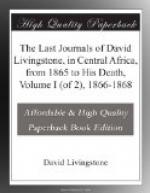We must not forget to record the fact that when Mr. Young reached Maponda, two years afterwards, to ascertain whether the Doctor really had been murdered, as Musa declared, he was most hospitably received by the chief, who had by this time a great appreciation of everything English.]
The lines of tattoo of the different tribes serve for ornaments, and are resorted to most by the women; it is a sort of heraldry closely resembling the Highland tartans.
[Illustration: Manganja and Machinga women (from a Drawing by the late Dr. Meller).]
FOOTNOTES:
[16] Coal was shown to a group of natives when first the Pioneer ascended the river Shire. Members of numerous tribes were present, and all recognised it at once as Makala or coal.—ED.
[17] Dr. Livingstone heard this subsequently when at Casembe’s.
[18] The greater part were driven down into the Manganja country by war and famine combined, and eventually filled the slave gangs of the Portuguese, whose agents went from Tette and Senna to procure them.—ED.
[19] Pronounced Mkata by the Waiyau.—ED.
[20] Earthquakes are by no means uncommon. A slight shock was felt in 1861 at Magomero; on asking the natives if they knew the cause of it, they replied that on one occasion, after a very severe earthquake which shook boulders off the mountains, all the wise men of the country assembled to talk about it and came to the following conclusion, that a star had fallen from heaven into the sea, and that the bubbling caused the whole earth to rock; they said the effect was the same as that caused by throwing, a red-hot stone into a pot of water.—ED.
[21] The Waiyau language differs very much from the Nyassa, and is exceedingly difficult to master: it holds good from the coast to Nyassa, but to the west of the Lake the Nyassa tongue is spoken over a vast tract.—ED.
[22] We shall see that more to the north the hump entirely disappears.
[23] It is very singular to witness the disgust with which the idea of drinking milk is received by most of these tribes when we remember that the Caffre nations on the south, and again, tribes more to the north, subsist principally on it. A lad will undergo punishment rather than milk a goat. Eggs are likewise steadily eschewed.—ED.
[24] To myself.—ED.
CHAPTER V.
Crosses Cape Maclear. The havildar demoralised. The discomfited chief. Beaches Marenga’s town. The earth-sponge. Description of Marenga’s town. Rumours of Mazitu. Musa and the Johanna men desert. Beaches Kimsusa’s. His delight at seeing the Doctor once more. The fat ram. Kimsusa relates his experience of Livingstone’s advice. Chuma finds relatives. Kimsusa solves the transport difficulty nobly. Another old fishing acquaintance. Description of the people and country on the west of the Lake. The Kanthundas. Kauma. Iron-smelting. An African Sir Colin Campbell. Milandos.




